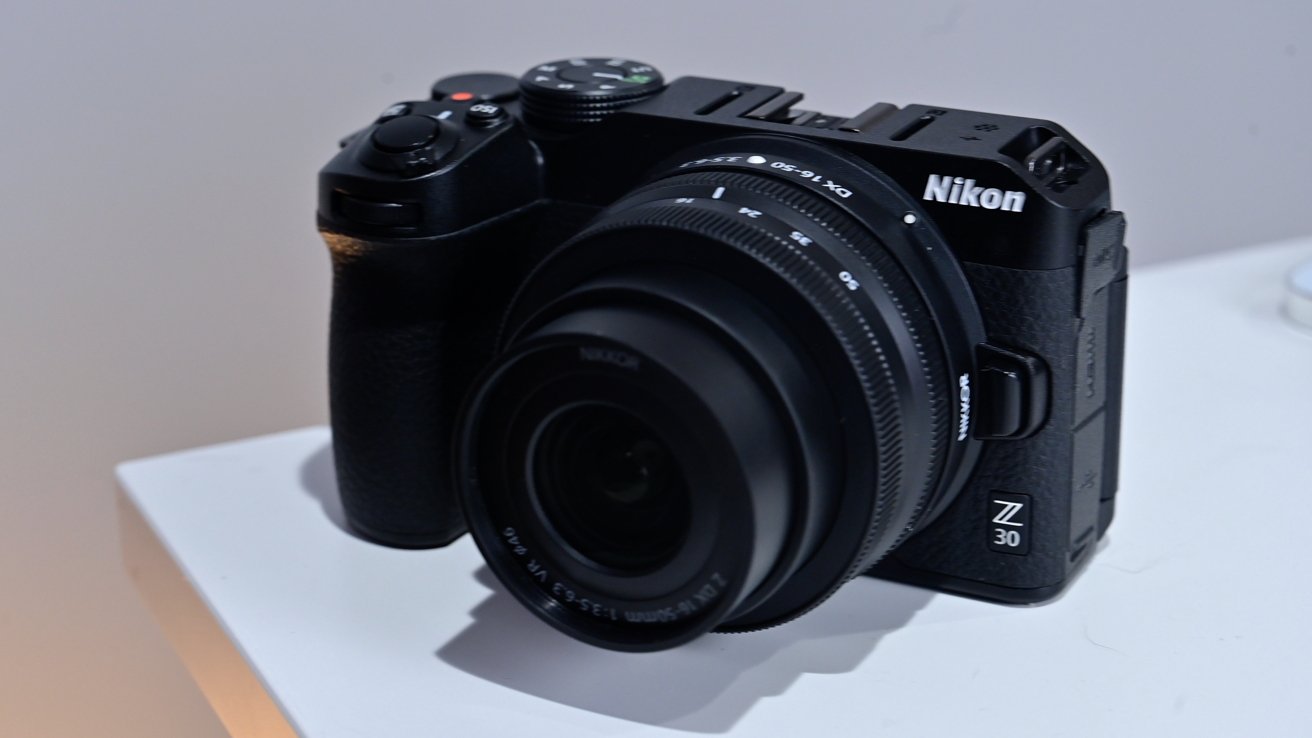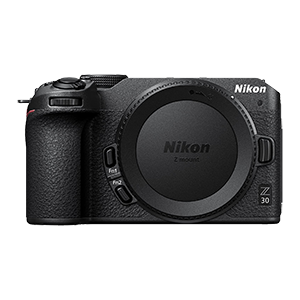The Nikon Z 30 is the camera maker's most affordable mirrorless shooter yet, and it's designed with social media and video creators in mind.

Nikon Z 30
Nikon's mirrorless lineup continues to grow as the company has formally discontinued the future development of its DSLR line. The Z 30 sits at the bottom of the lineup, making it enticing to beginners while also catering to online social video.
This marks the third APS-C camera Nikon makes, coming below the Z 50 and the Z fc. The former is most similar with a few enhancements and the latter is going for a more retro look.
Aside from taking great photos, it's great for creators with no video capture cap, no crop on video, and exposure adjustment while in auto. Let's see why else this camera shines.
Nikon Z 30 - Basic specs
Inside the Nikon Z 30 is a 20.9-megapixel APS-C CMOS sensor. It uses Nikon's line of Z DX lenses that are intended to be lighter and more compact than the full Z-mount lenses.
APS-C 20.9 MP sensor
Shooting photos, it can fire off at 11 frames per second. It's capable of capturing a full 4K video at 30 frames per second as well as 1080P video at 120 frames per second.
Nikon's Expeed 6 processor powers the camera, which makes navigating the system quick and easy.
Shooting a selfie video
Nikon uses a hybrid autofocus system here with 209 focus points. It can track the subject in video and photo modes and includes an eye-detecting mode.
Nikon Z 30 - Design
The Nikon Z 30 has a magnesium alloy metal body. It has a strong, compact build that feels good in the hand. The screen has a plastic back which does take away from the solid feel, though, when closed.
Nikon Z 30 ports
Down the left-hand side is the port array. You'll find a USB-C port, a micro HDMI output, and a microphone input. Unfortunately, there is no headphone output to monitor audio levels.
Battery and SD card slot
The battery is inside the grip via a bottom-mounted door. Next to the EN-EL25 battery is a single SD card slot. It can use SD cards, SDHC cards, or SDXC cards.
We'd highly recommend using an SDXC card as they can be both higher capacity and faster.
Adjustable display
On the back, you'll find a three-inch fully articulating touch display. This TFT display has 1,040,000 pixels, the same as the Z 50 and Z fc. Since the Z 50 has a 3.2-inch display that gives the Z 30 a higher pixel density.
It still isn't as sharp as the high-end Nikon models but it is certainly adequate.
Also on the back is a button array that will feel familiar to any previous Nikon user. There's a toggle for photo and video mode, menu and info buttons, as well as a directional pad.
Some stuff has shifted to make it easier for video creators such as putting the video record button on top, rather than on the back. Going from older Nikons may take a little time to relearn muscle memory.
Mode dial on Z 30
On top is a mode dial with auto, program, aperture preferred, manual, shutter priority mode, and two custom user modes. There is also the shutter, video record button, ISO control, and exposure compensation.
Many mirrorless cameras don't have an automatic mode but it's beneficial for this entry-level model. Unique to the Z 30 is the ability to adjust the exposure compensation while in automatic mode.
Then novice users can rely on the camera to do the heavy lifting but still control the lighting in the shot.
The Z 30 notably doesn't have an electronic viewfinder. The lack of an EVF will surely be polarizing though we didn't have too much of an issue with it. The Z 50 has an EVF if it is a necessity.
Stereo mics
Though it lacks an EVF, it still has a hot shoe mount for connecting various accessories such as external microphones or flashes. On either side of the hot shoe is a microphone grille for stereo audio recording.
Unlike the Sony ZV-E10, Nikon doesn't include wind guards in the box. Not everyone will use them but they're a low-cost accessory Nikon shouldn't require users to buy separately.
Finally, the front has a small tally light to signify when a video is actively recording.
Nikon Z 30 - Lenses
Nikon Z series is still fairly new in the grand scheme of things but its Z DX lenses still are rather lacking. There are three APS-C cameras to use the Z DX lenses and there are three lenses to go with.
We used the Z DX 16-50mm F3.5-6.3 VR lens in our review and found it more than capable. A Z DX 18-140mm VR and Z DX 59-250mm VR are also available if you'd like something with a bit more zoom.
All three lenses include VR as the Nikon Z 30 doesn't include any sensor-level stabilization so the vibration reduction must come from the lens itself.
Nikon Z DX 18-50mm lens
Users can use any of the larger Z-series lenses with the Z 30 though they are bigger, heavier, and bulkier. The F to Z adapter can be attached to vintage lenses if worse comes to worse.
Nikon Z 30 - Smart connectivity
Like Nikon's other recent cameras, the Z 30 can connect to your iPhone or iPad via the Snapbridge app.
Remote capturing via Snapbridge
When connected, you can shoot with the camera as well as transfer photos.
Camera control allows you to make multiple adjustments including what is in focus, the exposure, and more. To transfer photos, you can choose small 2MP images for proofs or you can download them in their original quality.
Snapping pics with the Nikon Z 30
We took the Z 30 along with us to several locations. We relaxed on the lake, visited a lighthouse, and attended a local high school football game.
The camera was perfect for traveling thanks to its small, compact size. We found ourselves trying to use the viewfinder at first since our other cameras have them, but this went away after a few days.
The autofocus system did an admirable job, following people, objects, and pets as they moved in the frame. We could move quite fast and the autofocus system managed to keep up.
Previewing photos on the Z 30
Nikon says you can capture about 330 shots on a single charge and this was quite conservative based on our experience. We were able to nearly double that shot count before our camera died.
Even if the battery didn't last that long the USB-C port was very handy. We never bothered taking the battery out of the camera but instead charged up on the go via USB-C.
We just plugged the camera into a USB-C battery pack with Power Delivery support and it stayed topped off at all times.
Nikon Z 30 - Capturing video
The Z 30 is built on a great processor and a great sensor. While it's exceptional for capturing photos, it has a clear video focus.
Still frame sample from a Z 30 video
For one, there is no crop when shooting video, regardless of resolution. Some of its biggest competitors do crop video depending on which resolution you're shooting in.
This is hugely crucial for video creators who are shooting handheld videos of themselves when you need a wide shot to fit everything in the frame.
Still image from a video
It also has ditched the artificial 30-minute video capture limit. You can shoot until your camera gets too hot or the battery dies. In most cases, this will be around 75 minutes.
Still frame from a Nikon Z 30 video clip
There are several video modes available including 120 frames per second at 1080P, and 30 and 24 frames per second at 4K, among others. Streamers can live stream at up to 60 frames per second at 1080P.
In our testing, the video was sharp and clear, and the autofocus system tracked our subjects perfectly. We did find the record button to be a bit difficult to hit when facing the camera towards ourselves.
More shooting with this camera will make this a bit more natural.
The audio sounded great, despite the lack of wind covers in the box. If you want to up the audio quality, you can grab an external mic or the creator kit that bundles a tripod, remote, and Rode mic.
Should you buy the Nikon Z 30?
We're big fans of the Z 30. It lacks a headphone jack and EVF but it has a steller sensor with crisp photos, fast autofocus, and lots of video-centric features.
Nikon Z 30
It has nearly everything a mobile creator could need. Un-cropped 4K video, awesome audio quality, and easy one-handed use.
There are times when we missed certain features but know they're available on many models above the Z 30. Think of the EVF, headphone jack, or sensor stabilization.
Nikon Z 30 with creator kit tripod and mic
Whether you want an affordable and reliable mirrorless camera or you want to start capturing video for sharing online, the Nikon Z 30 should certainly be in consideration.
Nikon Z 30 pros
- Fair price
- Great image quality, including in low light
- Stereo audio capture
- Won't crop video at any resolution
- Articulating touch screen can be protected when not in use
- Better-than-promised battery life
- USB-C charging
- App connectivity and remote control
- Streaming support for 1080P, 60 frames per second
Nikon Z 30 cons
- No EVF or headphone jack
- Not a large selection of lenses yet
- Wind covers not included
Rating: 4.5 out of 5
Where to buy
The Nikon Z30 Mirrorless Camera starts at $706.95 for the body, with savings available when you buy a kit bundled with one or more lenses.
These retailers all carry the Z30:
More sample shots

